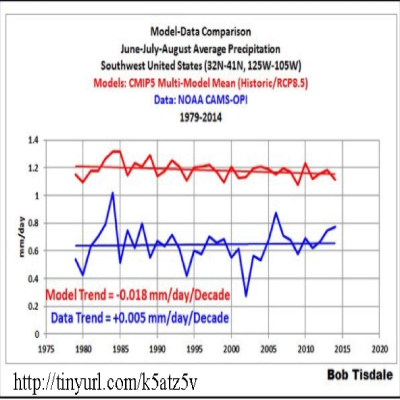
 Tony Davis has another climate scare story in the Arizona Daily Star: “Study: Worst SW drought in 1,000 years coming.” We should expect more stories like this because polling shows that “global warming” is not of great concern among the public, but many interests such as the money-grubbing IPCC, the EPA, and alternative energy companies depend on maintaining the myth of CO2-caused global warming. Tony writes: “Due to human-caused global warming, this region and the Great Plains are likely to experience droughts from 2050 to 2100 that are worse than the ‘megadroughts’ that lasted up to 60 years in the Southwest in pre-Medieval times, the study said.”
Tony Davis has another climate scare story in the Arizona Daily Star: “Study: Worst SW drought in 1,000 years coming.” We should expect more stories like this because polling shows that “global warming” is not of great concern among the public, but many interests such as the money-grubbing IPCC, the EPA, and alternative energy companies depend on maintaining the myth of CO2-caused global warming. Tony writes: “Due to human-caused global warming, this region and the Great Plains are likely to experience droughts from 2050 to 2100 that are worse than the ‘megadroughts’ that lasted up to 60 years in the Southwest in pre-Medieval times, the study said.”
You can read the full study here. If you do, you will find that the study is based on failed computer models, statistical inference, and manipulation of data.
Bob Tisdale has some comments about this paper at the WattsUpWithThat blog. The thing about Bob is that he has this nasty habit of comparing computer model predictions against actual observational data.
Below, I show one of Bob’s graphs. This graph compares June-July-August precipitation data from 1979-2014 for both climate models (red) and observations (blue).
There are two things to notice about this graph. First, the models have always predicted that there would be twice as much precipitation than has actually occurred. Therefore a “modeled drought” might just be the model’s approach toward realty. Second, all the models show a slight decreasing trend in precipitation when in reality there has been a slight increasing trend in precipitation.
The drought scare seems to be a persistent theme. Back in August, Tony had another drought scare story featuring some of the same researchers (see: Megadroughts and the Arizona Daily Star). In that previous story the researchers had this disclaimer:
“An obvious limitation of our work is that it is ‘blind’ to certain aspects of dynamically-driven changes in prolonged drought risk. For instance, changes in the magnitude, frequency, or teleconnection patterns of El Nino and La Nina (e.g., Coats et al. 2013) may alter the statistics of interannual variability in ways that are not captured by our simple models. Further, megadrought statistics over the last millennium may be forcing-dependent, as suggested by Cook et al. (2004), for instance, which shows that megadroughts were more common during the medieval climate era of 850-1200 CE. Another very serious limitation is imposed by the reliability of the models themselves to make realistic predictions of changes in climatological precipitation for the end of the 21st century.”
One other thing, both Tony Davis and the study authors claim “human-caused global warming.” Yet, to my knowledge, no one has presented any physical evidence to support the contention that our carbon dioxide emissions are a significant factor.
In a previous article, I show, with observational evidence, that the much touted enhanced greenhouse effect from our carbon dioxide emissions does not exist, see: Evidence that CO2 emissions do not intensify the greenhouse effect .
See also:>
